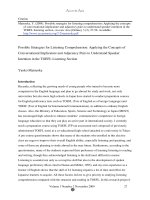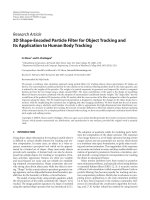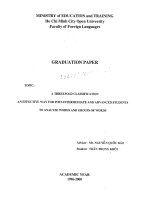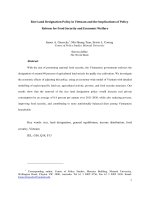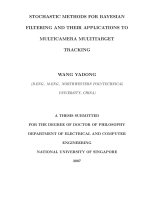The Nontraditional Path - Help for Non-Education Majors and Those Returning to the Field
Bạn đang xem bản rút gọn của tài liệu. Xem và tải ngay bản đầy đủ của tài liệu tại đây (161.14 KB, 9 trang )
CHAPTER 5
The Nontraditional Path:
Help for Non-Education
Majors and Those
Returning to the Field
W
e’re all familiar with the adage, “It’s a matter of being in the right place
at the right time.” Well, this is particularly relevant to the current situation
in the teaching field, where school districts are desperate to fill their teaching
vacancies and there aren’t enough qualified candidates available.
So, enter the career switchers and teachers returning to the profession after a long
absence.
So Why Do You Want to Be a Teacher?
Why are so many of you changing careers at this stage of your lives? These are the
reasons you have given us:
●
You’re retiring from your current profession, many with full retirement
benefits, and you want a meaningful second career.
●
You’re being laid off in the current round of corporate downsizing and have
decided to pursue classroom teaching, which is perceived as a more stable
area.
●
You’re not feeling fulfilled with your current career.
●
You’re a working mother who’s been in a high-stress career that demanded
long hours and lots of overtime. You have decided to pursue a teaching
career where the hours are similar to your kids’ schedules.
Those of you who are returning to the teaching profession after being out of it for
many years might be coming back for one of the following reasons:
●
You were trying out a different profession and didn’t find it to be rewarding.
© JIST Works
Inside Secrets of Finding a Teaching Job ____________________________________________
94
●
You’ve been unemployed for a number of years, perhaps serving as a stay-at-
home parent, and now must seek employment because your spouse has been
laid off with the recent corporate downsizing. Or, your kids might be grown
and out of the house and this is your time to enjoy a career of your own.
Also, research has shown that many who are now seeking to enter the teaching
profession are doing so because of the 9/11 tragedy. The tragedy has caused many
of us to rethink our priorities and to want to spend the rest of our lives contribut-
ing in some meaningful way. Of course, is there a more meaningful and reward-
ing profession than teaching?
It’s interesting that at a recent open house for mid-career switchers held by the
Bank Street College of Education in New York, they saw a record turnout of
people who are rethinking their lives and wanting to get into the teaching field.
If you fall into any of these categories, we have wonderful news for you: You’re
definitely in the right place at the right time. This is your golden opportunity to
secure a teaching position.
School Districts Are Seeking Second-
Career and Returning Teachers
School districts are looking for those in their 40s and 50s who have retired from
their first careers or given up on their first career choices because they weren’t
satisfying. Many of these candidates are retired military or government workers
who have all their retirement benefits and are looking for a rewarding, fulfilling
second career. The districts are also seeking out teachers who are returning to the
profession after a lengthy absence.
Fortunately for all you nontraditional teacher candidates, you’ll have very little
difficulty finding a teaching position because school-district administrators like
you. They find older first-year instructors bring more life experience to the
classroom than the traditional 22-year-old college graduate.
One administrator said that he’s found that
an older person has been in the real world
and can tell the students what they can expect.
Another said that career switchers bring a
wealth of experience and a sense of dedication
to the task.
2.4 million new
teachers will be needed
nationwide by 2008.
—National Center for
Education Studies (NCES)
________________________________________________ Chapter 5: The Nontraditional Path
© JIST Works
95
Creative Incentives
School districts have such an astounding shortage of teachers, in fact, that they’re
coming up with all kinds of creative incentives to entice applicants:
●
Signing bonuses and stipends, especially for bilingual teachers, math
teachers, and science teachers
●
Low-interest mortgages
●
Low-cost housing
●
Discounts at local businesses, including dry cleaners and auto-repair shops
●
Reimbursement of college expenses
●
Van shuttles to transport teachers from their homes to their teaching jobs
●
Recruitment of student teachers who have barely started their student-
teaching assignments, moving them directly into available positions before
they have received their teaching credentials
●
Recruitment of career switchers, placing them into existing positions while
they pursue their teaching credentials outside of their school responsibilities
●
Recruitment of foreign teachers, including
sponsoring work visas, which are good for up
to six years
●
Recruitment of former military personnel
Universities, colleges, and the federal government
are also coming up with innovative ways to get
more career switchers and returning teachers
trained and ready to fill positions:
●
Implementation of fast-track teacher-preparation programs by colleges and
universities
●
Development by school districts of programs to help career switchers and
returning teachers make an easy transition into current teaching positions
●
Development by the Defense Department of the Troops to Teachers pro-
gram, E-March, a campaign to snag soon-to-retire military officers, plus
joint teacher-recruitment ventures, such as the Army Transition Project,
a joint venture between the military and the Florida Department of
Education
The City and County of
San Francisco have
recently hired 500
teachers who do not
have their full teaching
credentials.
© JIST Works
Inside Secrets of Finding a Teaching Job ____________________________________________
96
Programs for Recruiting and Training New
Teachers from Other Fields
Most states allow career switchers who don’t have a B.A. in education to teach
on a temporary basis, although they are usually required to become certified
within one or two years. We know of teachers who take several one- or two-day
classes during the summer and evening classes during the school year, plus teach
summer-school courses under the guidance of certified teachers. With all of this
combined training, they expect to become certified teachers within a two-year
period.
Many school districts around the country are developing their own fast-track
programs for career switchers and returning teachers who are transitioning back
into the teaching profession. San Jose, California, for example, has a program
called the Teaching Fellows Program that provides coaching and mentors to work
with career switchers who have B.A.s in other fields. Jennifer, a former dot-
commer who did not have a teaching credential, was placed in a seventh- and
eighth-grade teaching position, and with the help of the Teaching Fellows
Program, she is working toward her credential.
New York City, which has the largest school district in the nation, has recently
solicited mid-career professionals through its Teaching Fellows Program. School-
district officials were surprised to have more than 2,300 applicants. After only a
month-long training session, 325 of these applicants were chosen to teach in the
city’s classrooms. Meanwhile, these applicants are also enrolled in an accelerated
master’s degree program. Surprisingly, these applicants included lawyers, doctors,
and a retired judge.
The city of Chicago has launched a Global Educators Outreach Program, which
has provided teachers from India, Colombia, and the Philippines. Many of these
teachers were college professors in their home countries.
Tucson, Arizona, is hiring career
switchers who have graduated from
the University of Arizona’s Teach for
Tucson’s fast-track program. This
program leads to a Master’s degree in
Education and a teacher certifica-
tion in only one calendar year. The
University of Arizona received
more than 800 inquiries for the
first 30 openings when the
program debuted in May 2000.
Teach for Tucson has tapped an
essentially unaddressed niche: “the
mid-career professional who
perhaps had very successful
experiences—but maybe part of
that experience was not as fulfilling
as they thought it might be.”
—Robert Hendricks, Assistant Dean for
Professional Preparation, University of
Arizona College of Education
________________________________________________ Chapter 5: The Nontraditional Path
© JIST Works
97
To date the program has produced nearly 60 secondary-education teachers and 30
elementary teachers. A preference is given to applicants with some type of
undergraduate background in math, science, or Spanish.
North Carolina is another excellent example of a state that’s had to develop an
innovative program to train more teachers. They have started working with their
state’s teacher colleges to establish a Grow Your Own Teacher Program. The goal of
this program is to provide teacher-education courses for students who are isolated
from colleges and universities by providing visiting professors, long-distance
education over the Internet, and live videoconference classes.
Nontraditional students are making the transition to fast-track college teaching
programs very quickly, taking less time to graduate than students in their 20s and
making better grades than typical college students. Also, because nontraditional
students are often on very tight budgets, they are highly focused. In fact, their
motto is: “Get in, study hard, get out, and find a teaching job.” These students
aren’t concerned about joining a fraternity or a sorority, and they couldn’t care less
about upcoming homecoming game festivities. They’re in this for one purpose
and one purpose only: to become qualified to teach
and be employed as quickly as possible.
As far as the Defense Department goes, there are
currently about a million veterans close to
retirement, many of whom are too young to
retire permanently and want to do something
else with their lives until they reach permanent
retirement age. Many of these people will take advantage
of the Troops to Teachers program and become teachers.
A Teacher Needs Many Skills That You
Probably Already Have
Not only must a teacher be a multitalented person, but the field of teaching is
a multidimensional profession. In our first book, The Unauthorized Teacher’s
Survival Guide, we talk about the fact that a teacher is required to wear many
hats during any given day in the classroom:
●
Surrogate parent
●
Friend
●
Social worker
●
Provider
More than 12 percent of
all newly hired teachers
enter classrooms
without any training.
—National Commission on
Teaching and America’s Future
●
Psychologist
●
Nurse
●
Emergency worker


